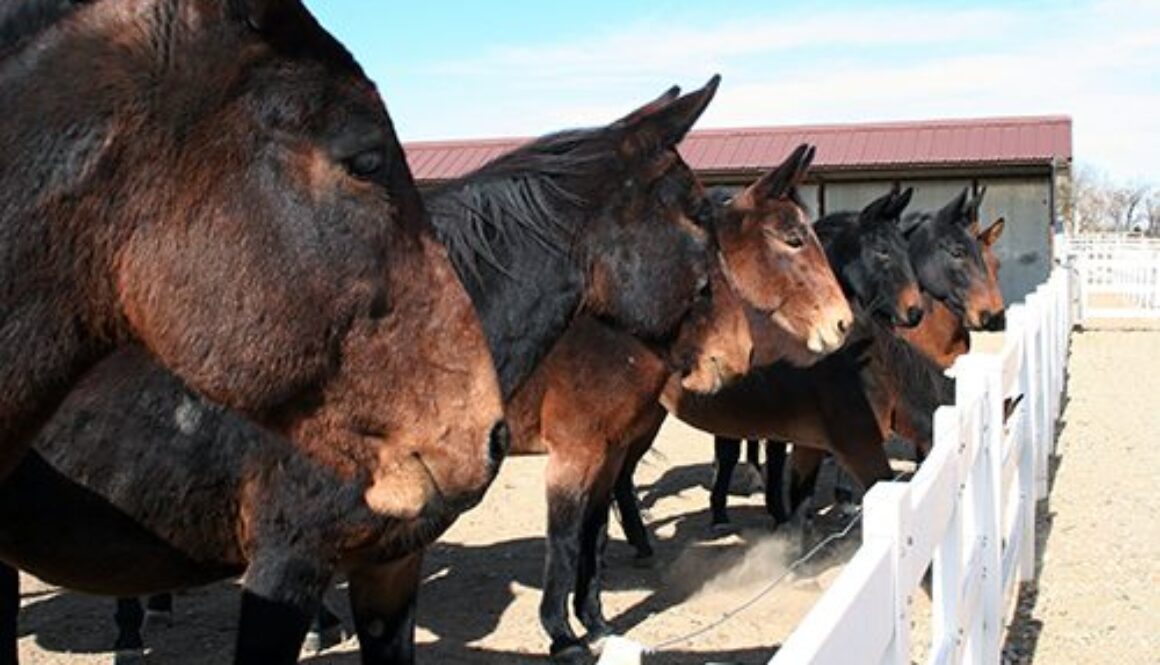MULE CROSSING: Stubborn As A Mule
By Meredith Hodges
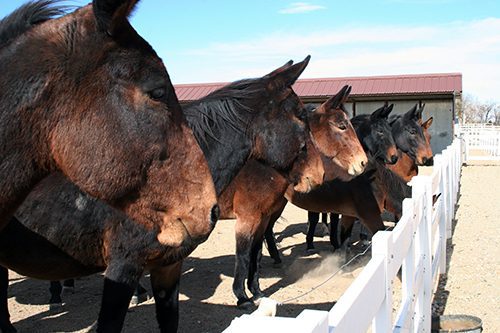 “Stubborn as a mule” is hardly an appropriate cliché to describe today’s mules who are sweeping the countryside with their remarkable abilities! But why now? Why haven’t mules been used successfully as saddle animals before this? My only guess is that in the past, we did not afford ourselves much leisure time out of necessity. Therefore, mules used for packing and farming had to be broke quickly to help with the work. They were generally trained by older and more experienced animals by working in teams. People did not have the time to spend training one horse, much less one mule! If an animal refused to learn under the “team” plan, he was quickly discarded for an animal that would. Today we find that to train mules successfully for a variety of uses, we must spend a lot of quality time with them to get the desired response. Mules do not profit from hasty or forced training. With this new approach to training mules, they are rapidly becoming a preferred saddle animal.
“Stubborn as a mule” is hardly an appropriate cliché to describe today’s mules who are sweeping the countryside with their remarkable abilities! But why now? Why haven’t mules been used successfully as saddle animals before this? My only guess is that in the past, we did not afford ourselves much leisure time out of necessity. Therefore, mules used for packing and farming had to be broke quickly to help with the work. They were generally trained by older and more experienced animals by working in teams. People did not have the time to spend training one horse, much less one mule! If an animal refused to learn under the “team” plan, he was quickly discarded for an animal that would. Today we find that to train mules successfully for a variety of uses, we must spend a lot of quality time with them to get the desired response. Mules do not profit from hasty or forced training. With this new approach to training mules, they are rapidly becoming a preferred saddle animal.
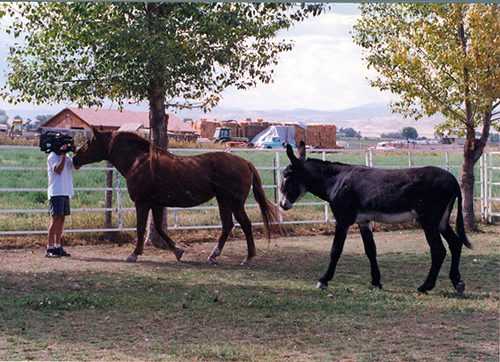 It does not seem strange to me that this phenomenon with mules is finally taking place. A mule usually inherits his strength and intelligence from the jack and his beauty and athletic ability from the mare. Of course, both the jack and the mare can contribute more and less, of each other’s major attributes varying the looks and abilities of the offspring. Still, the offspring of a given mare will exceed the abilities of that mare after adding the jack’s incredible strength and intelligence. It is no surprise, then, in the face of this evidence, that using an athletic, sport mare will produce a sport mule, and so on.
It does not seem strange to me that this phenomenon with mules is finally taking place. A mule usually inherits his strength and intelligence from the jack and his beauty and athletic ability from the mare. Of course, both the jack and the mare can contribute more and less, of each other’s major attributes varying the looks and abilities of the offspring. Still, the offspring of a given mare will exceed the abilities of that mare after adding the jack’s incredible strength and intelligence. It is no surprise, then, in the face of this evidence, that using an athletic, sport mare will produce a sport mule, and so on.
In Europe, the Equestrian Arts are revered and preserved on a majority basis. In the United States, equestrians are a minority, taking a back seat to baseball, football, and other sports of the “common man.” Still, there is a 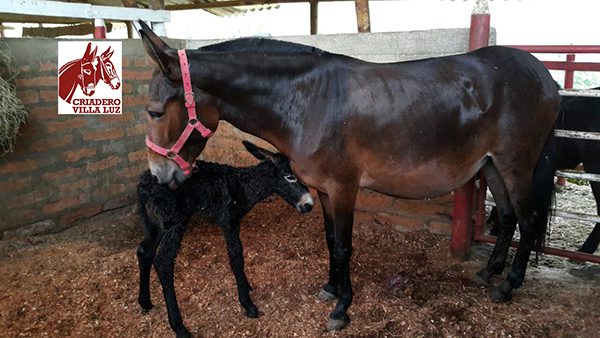 marked growth of equestrian skills and equine performance that CAN carry us into the future with added equestrian interest. The spectators of Equestrian Sports must be considered. It is the spectator who pays to support us and it is the nature of the spectator to want to be entertained. In order to preserve their interest, we must keep them abreast of new developments in our industry, new events, new people, and new animals that now include mules! Since mules are now successfully competing with and against horses, it only stands to reason that they can be an asset to the industry as new talent. A complete list of uses and accomplishments of the mule is still not possible since the mule has not been tested completely, but that which has been tested is positive, including testing as an embryo transplant recipient. The mule has many redeeming qualities that make him attractive to Equestrians: he is durable, intelligent, extremely surefooted and less expensive to maintain than are horses. An added bonus is the affectionate, mischievous nature of the mule when treated kindly and fairly.
marked growth of equestrian skills and equine performance that CAN carry us into the future with added equestrian interest. The spectators of Equestrian Sports must be considered. It is the spectator who pays to support us and it is the nature of the spectator to want to be entertained. In order to preserve their interest, we must keep them abreast of new developments in our industry, new events, new people, and new animals that now include mules! Since mules are now successfully competing with and against horses, it only stands to reason that they can be an asset to the industry as new talent. A complete list of uses and accomplishments of the mule is still not possible since the mule has not been tested completely, but that which has been tested is positive, including testing as an embryo transplant recipient. The mule has many redeeming qualities that make him attractive to Equestrians: he is durable, intelligent, extremely surefooted and less expensive to maintain than are horses. An added bonus is the affectionate, mischievous nature of the mule when treated kindly and fairly.
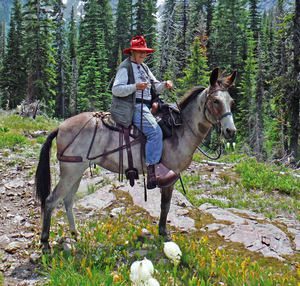 Sometimes we humans fall into the belief that one breed is better than another (with mules at the bottom, of course?!!!) when we should actually be looking at the whole picture a lot more realistically! It really isn’t that one breed is better than another. Rather, there are individuals within every breed who will excel. Whether that individual is a Warm Blood or a mule, shouldn’t he have the support of the entire equine industry and not just the support of his own breed?! If we had not integrated baseball, or football, for example, do you think it would have grown into the industry that it is today?! Probably not! Together we stand, divided we fall. Bickering over such trivialities in or own industry creates dissention and separation of resources. Better to use all the resources we have available to us in a positive and favorable manner for the support and preservation of our entire equine industry. Let’s get our priorities straight and do it for the survival of our industry, do it to improve your own skills, and do it to improve your equine’s skills! Try to keep your personal feelings in check for the sake of the whole and appreciate the art and skill of all our equestrians in the learning process. We can all learn from each other. “Mules can make a viable contribution to equestrian events… if we only give them a chance!!!!”
Sometimes we humans fall into the belief that one breed is better than another (with mules at the bottom, of course?!!!) when we should actually be looking at the whole picture a lot more realistically! It really isn’t that one breed is better than another. Rather, there are individuals within every breed who will excel. Whether that individual is a Warm Blood or a mule, shouldn’t he have the support of the entire equine industry and not just the support of his own breed?! If we had not integrated baseball, or football, for example, do you think it would have grown into the industry that it is today?! Probably not! Together we stand, divided we fall. Bickering over such trivialities in or own industry creates dissention and separation of resources. Better to use all the resources we have available to us in a positive and favorable manner for the support and preservation of our entire equine industry. Let’s get our priorities straight and do it for the survival of our industry, do it to improve your own skills, and do it to improve your equine’s skills! Try to keep your personal feelings in check for the sake of the whole and appreciate the art and skill of all our equestrians in the learning process. We can all learn from each other. “Mules can make a viable contribution to equestrian events… if we only give them a chance!!!!”
To learn more about Meredith Hodges and her comprehensive all-breed equine training program, visit LuckyThreeRanch.com or call 1-800-816-7566. Check out her children’s website at JasperTheMule.com. Also, find Meredith on Facebook, YouTube and Twitter.
© 1989, 2016, 2021 Lucky Three Ranch, Inc. All Rights Reserved.

